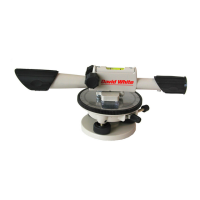-8-
Turn both screws at the same time by
moving your thumbs toward each other
or away from each other, until the bubble
is centered.
When the bubble is centered, rotate the
telescope 90 degrees over the leveling
screw (C) and turn the screw until the
bubble is again centered.
Shift back to the original position and
check the level. Make minor adjustments
with leveling screws if necessary.
Final Level Check
Rotate the instrument 180° so the vial
is reversed. If the bubble will not center
when reversed, follow adjustment
procedure outlined under “Bubble
Adjustments.”
Bubble Vial Adjustment
Bubble adjustments must be correct if
proper results are to be obtained using the
instrument.
If the telescope bubble does not
remain centered after having leveled
the instrument, and reversed the
telescope end for end (180°) the need
for adjustment is indicated. Use a
screwdriver.
50
40
30
20
10
20
30
40
With the bubble level adjustment screw 17
facing to the right of the bubble and with
telescope directly in line with two of the
three leveling screws, note to which side
the bubble is off.
If to the left, loosen screw A very slightly to
remove ONE-HALF the error. Remove the
other half of the error with the two level
screws in line with the telescope.
If the bubble is still not exactly centered,
repeat the procedure.
If bubble is off to the right, tighten the
bubble level adjustment screw 17.
Otherwise, the procedure is identical.
Reading the Circle and Vernier
The 360° horizontal circle 5 is divided in
quadrants (0 - 90°). The circle is marked
in degrees and numbered every 10
degrees. The horizontal circle 5 is referred
to as the circle or degree scale. On the
LT6-900 transit level, the vertical arc 10
also is a degree scale, and it is numbered
every 10 degrees to 45 degrees, up and
down.
For very precise readings, the instruments
are equipped with a horizontal vernier 16
which divides each degree on the circle or
arc into 12 equal parts of 5 minutes each.
There are 60 minutes (60’) in a degree.
The vernier scale 16 is read in the same
direction (right or left) as you’re reading
the degree scale.
The following examples will explain how to
read the degree and vernier scales on the
circle and arc.

